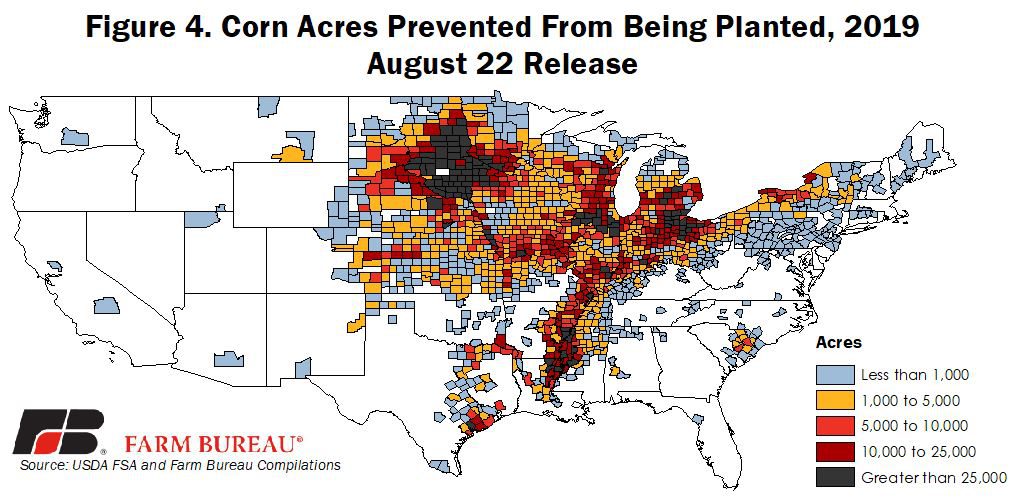Prevent Plantings Set Record in 2019 at 20 Million Acres
TOPICS
Soybeans
photo credit: AFBF Photo, Mike Tomko
John Newton, Ph.D.
Former AFBF Economist
Historic flooding in the early spring and record rainfall across portions of the Corn Belt led many in the industry to expect prevent plantings, i.e., the failure to plant an insured crop, to reach record highs in 2019, and the latest crop report bears that out. Prevented planting payments provide crop insurance benefits to policyholders to compensate for pre-planting costs incurred in preparation for planting the crop. For some farmers, these indemnity payments may exceed the economic returns associated with a late-planted and poor-yielding crop.
The previous prevent plantings record, set in 2011, was just shy of 10 million acres for the eight principle crops (Prevent Planting Implications for 2017). Recently released Farm Service Agency crop acreage data revealed that as of late August prevent plantings were record-high at nearly 20 million acres, more than double the previous record.
Prevented planting across all major crops was the highest in South Dakota at 3.9 million acres. Following South Dakota was Ohio at 1.6 million acres and Illinois at 1.5 million acres. Prevent plant acreage exceed 1 million acres in six states, across which prevent plantings totaled nearly 11 million acres, more than 50% of all filings in 2019. Figure 1 highlights total prevent plantings by state as of August 22 . These totals are preliminary as FSA will continue to update crop acreage data through January 2020. Totals will likely increase but are not expected to increase substantially.

At the county level, prevent plantings were the highest across portions of eastern South Dakota, northwest Ohio, northeast Illinois, southwest Minnesota and along the Mississippi. More than 200 counties had more than 25,000 acres in prevent plant. Of those counties, more than 80 had more than 50,000 prevent plant acres and 17 counties had more than 100,000 acres in prevent plant. Figure 2 details preliminary county-level prevent plant acreage.

Corn Prevent Plantings
The previous record for corn prevent plants was set in 2013 when 3.6 million acres were prevented from being planted. Over the last decade the average prevent plantings was 1.8 million acres. In 2019, corn acres prevented from being planted soared past the previous record by nearly 8 million acres to reach a new record of 11.4 million acres, 215% higher than the previous record. South Dakota led the nation with more than 2.9 million prevent plant corn acres and was followed by Illinois and Minnesota at more than 1 million acres each. Figure 3 highlights preliminary state-level corn prevent plantings in 2019 and Figure 4 identifies county-level corn prevent plantings.


Soybean Prevent Plantings
For soybeans, the previous record for prevent plantings was set in 2015 when 2.2 million acres were unplanted. Over the last decade prevent plantings have averaged just over 950,000 acres. In 2019, soybean prevent plantings totaled a record-high 4.5 million acres, 99% higher than the previous record. As it did with corn, South Dakota led the nation for the most soybean prevent plantings at 867 thousand acres, followed by Ohio at 628 thousand acres. Figure 5 highlights preliminary state-level soybean prevent plantings in 2019 and Figure 6 identifies county-level soybean prevent plantings.


Summary
Due to the historic flooding and precipitation across the Midwest many farmers were unable to plant an insurable crop, resulting in prevented plantings of nearly 20 million acres, more than double the previous record set in 2011. In many counties across the U.S. prevent plantings exceed 25% of total acreage, Figure 7. The concentrations were in South Dakota, along the Great Lakes, throughout Missouri and down the Mississippi River into Texas.
To assist farmers who were unable to plant an insurable crop, not only does USDA’s Risk Management Agency provide crop insurance benefits, but the department also provided an opportunity for farmers to plant a cover crop on these acres and not lose crop insurance benefits and also qualify for trade assistance payments of $15 per acre. Of the 20 million acres of prevent plant, more than 4 million acres have currently been planted to a cover crop, Figure 8.


Trending Topics
VIEW ALL